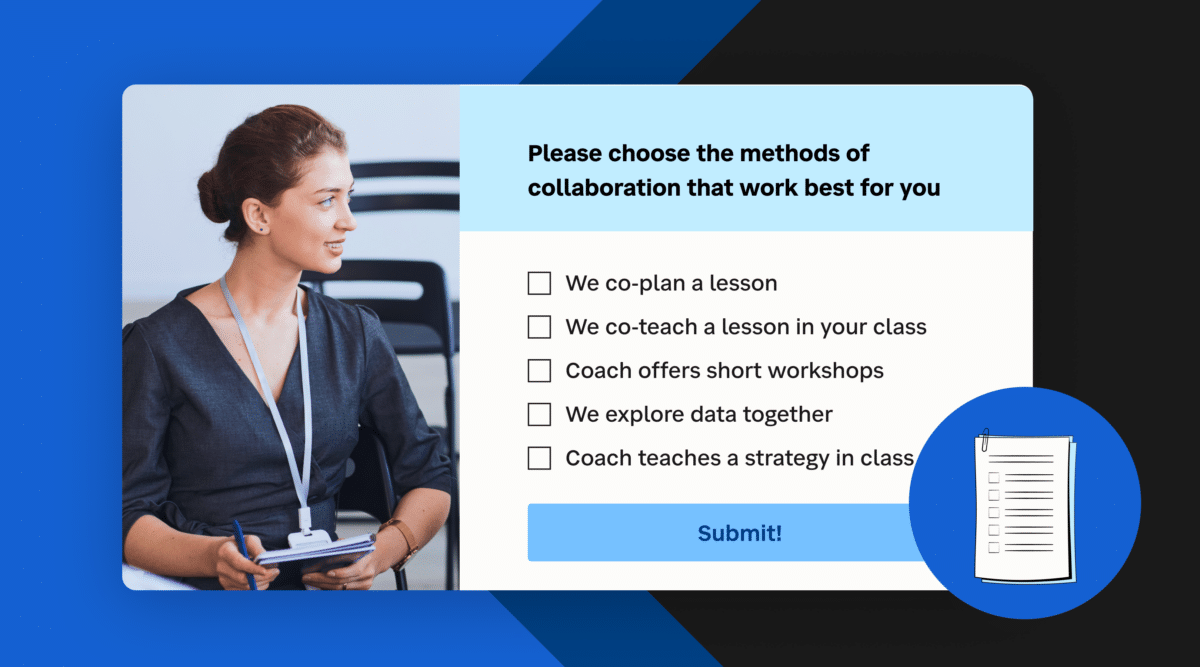

As an instructional coach, the best way to get started with teachers and coaching cycles is to “know your clients.” For as long as I’ve been a coach, I’ve always worked to create an understanding of what teachers need since, after all, they’re the coach’s client. To get to know them, you have to both break the ice and build credibility to develop a symbiotic connection nourished through relationships. One of the best methods of doing this is through informal and formal teacher surveys.
Answering questions like these will help guide schools to build the what, why, and how of collaboration.
Getting Started with Surveys
Building connections and relationships is an integral part of the informal survey process, as it helps a coach target specifics to include on formal surveys you’ll send out to teachers down the line. At the same time, it’s important for teachers to understand the role of the coach and our purpose in helping teachers grow in their practice. Here are a few ways to get started!
Begin With Making Connections
One of the best ways I make connections with teachers is through talking about good books. I like to stay on top of the latest hot reads, especially in picture books, and prefer to host read-aloud sessions with teachers to create an opportunity to build connections with both students and teachers.
In the past, to get things going, I’ve posted a sign-up sheet for teachers to select the best time to read aloud to the class. Once they select a time, I come in and support them with reading, and we all learn more about each other. I believe this is part of building credibility with the teachers, and is especially helpful at the start of a new school year or if the coach is new to the school. The routine of reading aloud with classes also helps develop background knowledge of the teacher’s classroom practices.
Send and Share Surveys
After teachers and the coach begin to make connections and build common experiences together, the coach can then use surveys to foster a deeper relationship. Sending them out through SchoolStatus Connect, by email, or one of the many online form tools can be even more useful.
Once a teacher completes a survey, the coach can begin to gather data to look for patterns and trends across multiple teachers or even buildings. In the past, I’ve used electronic forms (via Google) and paper in teachers’ mailboxes, and I’ve even handed out forms in person at staff meetings. Here are a few examples of surveys that I’ve used in the past:
- Professional Development Needs — teachers can self-rate their understanding of instructional routines and rituals within the building, invite the coach to demonstrate a lesson, or initiate a coaching cycle
- Coach Support Survey — teachers can indicate what they’d like to improve and their meeting availability
In one recent survey I distributed, I placed them in the teachers’ mailboxes along with a little survival kit based on an article on building resilience. I knew teachers were stressed out at the time and this survival kit contained a journal for documenting gratitude, a small bag of almonds to boost protein (as a reminder to eat healthily), a pencil as a reminder to make a smile, a candle as a reminder to seek peace and quiet, and some chocolate to help with stress. My coach liaison shared the idea of the building resilience kit at our weekly coach PLC and I then created kits for the teachers, along with the support survey. This led me to work on specifics with teachers who completed it, and the gesture was very well-received!
Use the Results
After getting results back from surveys, coaches can meet with teachers and begin to schedule the coaching cycle appointments. Coaches may want to collaborate with a building principal to determine priorities depending on what teachers have discussed through touch-base meetings with the principal.
It’s best to start with the teacher’s specific goal for the purpose of the coaching cycle. Ask questions based on the survey results to help guide the teacher in determining what they want to work on throughout the cycle; this allows the coach to determine how to plan for observing, modeling, or co-teaching. A key aspect of committing to the goal of the cycle will be making sure to set time aside for both short-term and long-term planning meetings to discuss how things are going.
Once plans are in place, determine the next steps on how to record the teaching. In the past, I’ve used scripting and tape recording, but since video is readily available, it can also be used for the coaching cycle. Whatever method you decide to use for recording, be sure to turn all of the media over to the teacher once the cycle is complete!
Final Note
Hopefully, all will go smoothly for both the coach and the teacher from the start of the survey to the end of the coaching cycle, while creating buy-in along the way. When using surveys to drive a coaching cycle, the end result will be a win-win for teacher performance, growing as a reflective practitioner, and impacting student achievement.
I’ll leave you with the wise words of coaching legend Bobby Knight: “To be as good as it can be, a team has to buy into what you as the coach are doing. They have to feel you’re a part of them and they’re a part of you.”
About Our Guest Blogger
Amy Rudd currently works as an instructional coach at the I Promise School in Akron, Ohio. She really loves children’s literature and always tries to connect new learning and great books while working with children and teachers.
Be sure to check out her personal blog, The Learning and Lead Cafe where she also contributes, and follow Amy on Twitter @AmyJoRudd!
Stay Connected
News, articles, and tips for meeting your district’s goals—delivered to your inbox.





